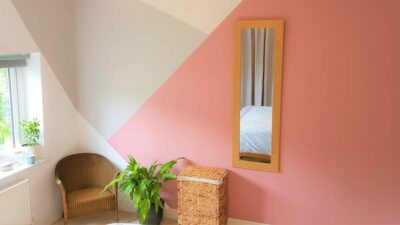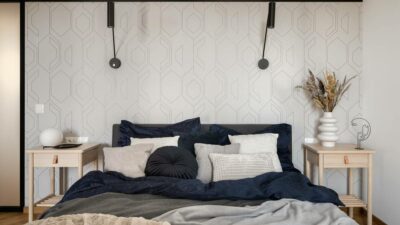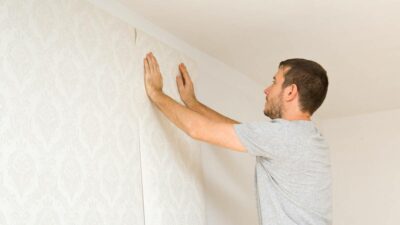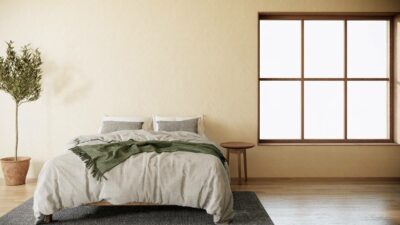Paint or Wallpaper: Which is better for your room?
Redecorating your walls requires a lot of effort and commitment, not just for your current home decor project, but for the long-term look and feel of the space. That’s why deciding between wallpaper vs. paint for your interior walls is a crucial decision.
From the installation and cost to aesthetics, this guide will walk you through the pros and cons of wallpaper vs. wall painting.
Advantages and disadvantages of painting
Dive into the world of wall painting, weighing its pros and cons for your next home project.
Wall painting advantages
It’s affordable
Materials are readily available, and very few supplies are needed to pull this off. Painting vs. wallpaper cost is generally lower because of this inexpensive and easy application.
It doesn’t require advanced skills for removal or application
Unlike wallpaper, painting requires considerably less preparation time since there’s no need to strip the walls. Of course, you will still need to prep the surface and sand it to start with smooth walls and for better paint adhesion.
Many paint varieties and colours to choose from
You can get textured paint or customisable paint colours for a wallpaper-like effect. If you want a patterned wall but prefer to use paint than wallpaper, there are patterned paint rollers that let you do this. In addition, you can get creative and use two or more colours on one wall.
Greater versatility
There are paint finishes that are more ideal to use based on the environment. For instance, satin, semi-gloss, and high-gloss paint finishes will work best in bathrooms where moisture can get high.
Wall painting disadvantages
Touch-ups can be costly
While a fresh coat of paint lasts 5 to 10 years, it will require touch-ups every 3 to 5 years. This is especially true for light-coloured paint in areas frequently exposed to sunlight since this is prone to flaking and peeling. You’ll also need to fix other common paint problems, such as blistering, paint bleeding, and discolouration or fading when they start to appear.
It may not cover imperfections properly
Wallpapers do a great job of covering holes, gaps, discolourations, chips, and other flaws on a surface. Meanwhile, painting may not cover all imperfections completely. If not done properly, you may need to repaint the area to fix it or maintain the wall’s appearance.
Advantages and disadvantages of wallpaper
Wallpaper advantages
Wallpaper gives a unique ambience
Regarding wallpaper vs. paint, wallpaper offers a quick and easy way to bring your walls to life through various patterns, designs, and finishes. It’s available in textures such as vinyl, fabric, and foil. You can introduce subtle patterns or make a statement with tropical and botanical prints in bedrooms or classic stripes in kids’ rooms.
Wallpaper lasts longer
If professionally applied and well-maintained, your wallpaper can last up to 15 years. This is a reliable option for long-term wall decor since it can save you frequent updates or redecoration. It’s also cost-effective, especially for those not too picky with walls or decor.
Wallpaper is good for covering up imperfections
Wallpapers are great for concealing gaps and chips. This includes scuff marks from moving the furniture around. It also won’t chip or flake the way paint will after a few years.
Regular cleaning is easier
Accidentally splattered coffee on the wall? Is it getting dusty? Just wipe the wallpaper down with a damp cloth, and your walls will look flawless again.
Wall painting disadvantages
It can be hard to DIY
Unlike painting, which can be learned quickly and done DIY, it’s harder to learn how to apply wallpaper. You’ll need a pro to install the wallpaper for you to ensure it will last long and maintain its good condition. Moreover, because of the complex removal process, stripping tools needed, and time-consuming application, installation costs tend to be higher for wallpaper.
You can’t apply wallpaper over an existing layer
While you can paint over existing wall finishes, an existing wallpaper must be thoroughly removed first before you can apply a new design or colour.
Wallpaper damage is harder to fix
Wallpaper is not immune to tearing. And when damaged, you’ll need to strip the existing wallpaper and re-apply it to achieve that smooth, flawless finish. Whereas, with paint, you can simply spot-treat a chip or flaking to fix the wall paint.
Wallpaper isn’t ideal for some rooms
High-traffic areas like your living room may make wallpaper more prone to tearing. You’ll also want to avoid choosing wallpaper for high-moisture and high-heat areas like your kitchen and bathroom since wallpaper can peel faster due to moisture and heat.
Paint vs. wallpaper: Factors to help you decide
Paint vs wallpaper cost
Wallpaper is more expensive upfront but can be more cost-effective. Meanwhile, the cost of wall painting is generally inexpensive in the short term. But paint has an increasing lifetime cost, from frequent touch-ups to a frequent need for application.
Labour for wallpapering is more expensive than painting labour costs. This is because painting preparation is a less tedious task than removing existing wallpaper and then preparing to install a new coat.
DIY wallpaper installation or painting
New wallpaper technology and easy application designs have made wallpaper a popular DIY option. However, in humid conditions, the glue in the wallpaper is prone to loosen, and its repair and removal will depend on the undercoat, so a professional is recommended in this case.
Meanwhile, it’s crucial to clean the surface properly before painting so it will adhere better to a clean surface. The surface must also be inspected for any mildew between tiles, on walls or bare wood. Any mildew or gloss will need to be removed before the paint is applied. The type of paint you use will determine the time you need to set aside to paint a wall.
In general, both are best done by experts. Even if you’re simply considering peel-and-stick wallpaper vs. painting, these methods require patience and expertise for that seamless finish. A skilled and seasoned professional can help achieve that immaculate application. Before you decide on a method, think about whether it’s best to do the redecoration yourself or hire a pro.
Considering aesthetics
Have you tried checking and comparing wallpaper vs painting designs? With paint, applying a coat of colour is an easy way to transform and distinguish different areas of the home. A coat of paint can bring elements of a space together to give the illusion of extra depth.
On the other hand, wallpaper can accentuate personal style to make a statement in a relatively easy way and can be a useful tool to cover an uneven or damaged surface.
Both painting and wallpapering offer a lot of room to play with. Consider exploring textured paints or creating a mural to capture the essence of wallpaper. Alternatively, investigate various wallpaper finishes and patterns, or opt for muted colours to mimic the effect of high-gloss paints. If you’re unsure what colour to use, you can consult a paint colour consultant for their expert advice.
Based on the room
Choosing between wallpaper and paint will also involve looking into the room you’ll give a makeover. Here are some things to think about:
- High-traffic areas are better off with paint to avoid wallpaper damage.
- In moist rooms like kitchens and bathrooms, stick to paint to prevent wallpaper from peeling.
- Children’s rooms are more suited for the paint to prevent tears, but durable, washable wallpaper can work too.
- Well-lit spaces can benefit from wallpaper due to paint’s tendency to peel under sunlight.
Simply put, decide based on room function, lighting, and budget for the best outcome.
In terms of maintenance
With paint, you can give your wall a quick clean with a warm, damp cloth to extend the life of your paint and ensure your wall looks great. Water-based paints are washable and will also dry quicker than an oil-based paint. For exterior walls, a gurney will be required to thoroughly clean them.
As for wallpapers, most types will include a label specifying how they should be maintained, but to be safe, commercial wallpaper cleaners are available for non-washable prints. A basic mix of warm water and cleaning detergent is suitable for vinyl and washable wallpapers.
Wallpaper vs. paint: Choose whichever works best for you
You might find yourself leaning towards one or the other based on your needs, budget, desired look, and the other factors shared above. Know and understand your needs and preferences to help you pick the best option for your interior walls.
Still stuck choosing between paint or wallpaper? Consult a professional painter to break down the two options or request free quotes to get started on your repaint or new wallpaper spread.
FAQs on paint or wallpaper
Is it better to wallpaper or paint?
It depends on your goals for redecoration. Paint offers more flexibility regarding upfront materials cost and labour, while wallpaper lasts longer but is more expensive to install. The two also have their ideal applications – for example, wallpaper is best in low-traffic, low-moisture rooms like bedrooms, while paint is great for living rooms and kitchens.
Why would someone choose wallpaper instead of paint?
You might favour wallpaper over paint if you’re looking for an easy way to achieve patterns or bold designs that are otherwise difficult to achieve using paint.
Wallpaper also lasts longer than paint, without constant retouching and repainting every few years, as long as it’s well-maintained. This finish would also work best for renters prohibited from painting their walls.
Is peel-and-stick wallpaper as good as regular wallpaper?
It depends. Peel-and-stick wallpaper is affordable and easy to install. It’s best for the casual DIY-er or someone who doesn’t plan to keep a theme or pattern for too long.
It’s deceptively easy. However, the lack of wallpaper paste means you don’t have any room for error with air bubbles or hanging the wallpaper straight. Also, unlike traditional wallpaper meant to last for years, peel-and-stick is, in essence, “temporary” wallpaper.